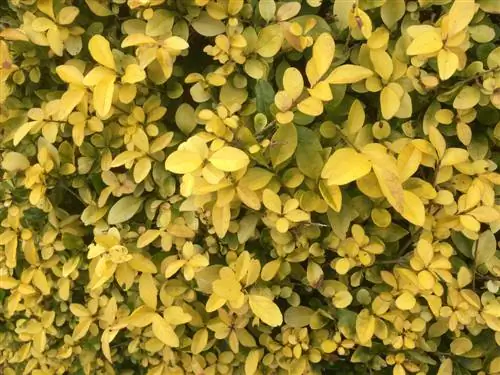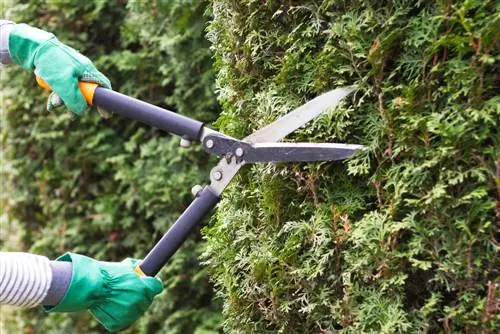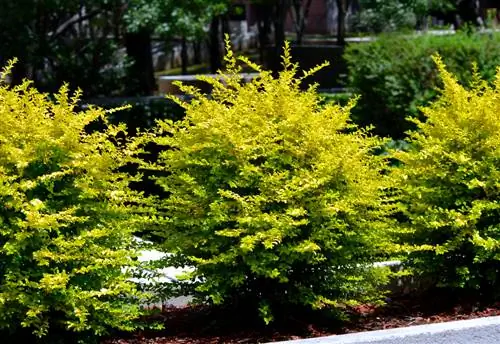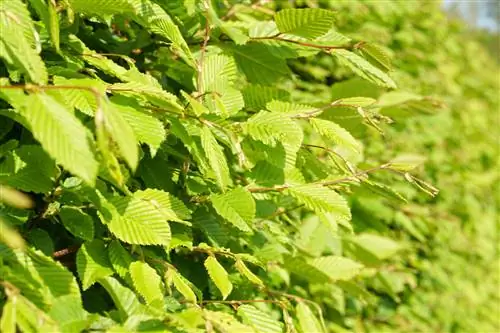- Author admin [email protected].
- Public 2023-12-16 16:46.
- Last modified 2025-01-23 11:22.
The fast-growing golden privet needs to be shaped and limited. That's why there's no way around the scissors. And since this plant is so easy to cut, it can be cut often and a lot. Gold privet forgives some cutting errors. But it's better if they aren't made at all.
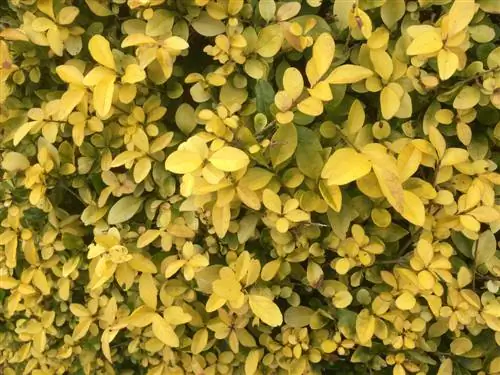
Education cutting hedge
Gold privet is usually used to create a living hedge. It must form plenty of branches so that it fulfills its privacy function. In addition, a densely leafy tree looks more attractive. Start cutting when planting:
- Cut back golden privet to approx. 15 cm when planted
- then let it grow approx. 30 cm
- cut again as soon as it has reached a height of around 50 cm
- cut back by 5 cm from all sides
- cut back every four weeks if growth is strong
Educational Cut Solitaire
A golden privet reaches heights of 2 to 3 m even as a solitary plant. It needs a stable framework and plenty of branches for a more beautiful crown.
- educate with 7-12 basic shoots
- shorten the strongest shoots
- remove weak shoots completely
- Slim down new growth in the following year
Conservation cuts
From a height of 50 cm, the golden privet needs a maintenance cut at least once a year. Two cuts per year are even better, as this tree can grow up to 60 cm annually. Privet hedges in particular quickly become out of shape without a second cut.
Ideal time
The optimal time for cutting is the end of February/beginning of March, before the golden privet sprouts again. The second cut should be done in summer after flowering.
The strong growth may require a third cut in autumn. But this poses dangers. This will stimulate new growth that will not become hardy in time and will therefore freeze to death on frosty days.
Tip
Pruning after flowering prevents the small blue-black berries from ripening. These are popular with many species of birds. But they are poisonous for us humans and our pets.
Cutting instructions
- Use disinfected secateurs (€14.00 on Amazon)
- cut thick branches with hedge trimmers
- cut off dry, broken and frozen branches
- remove branches growing inwards
- shorten the remaining branches to the desired length
- cut diagonally
- over an outward eye
Tip
Cutted shoots with a length of around 20 cm can be used for propagation. After they are initially allowed to form roots in water for weeks, they are planted in autumn.
Trapezoid shape
If the golden privet is part of a hedge, it is cut to different widths. It gets narrower from bottom to top. This trapezoidal shape is ideal because it means that the lower branches are not shaded. This prevents the hedge from becoming bald.
Cutting the high trunk
Gold privet can also be cultivated as a standard tree. The trade offers already refined and trained specimens for sale. The maintenance cuts serve to ensure dense branching and to maintain the round crown shape.

